The More Things Change, the More They Stay the Same
By Jena Pierce on
 In a fall day in 1985, Brad Gibbens began working at
the Center for Rural Health (CRH) on the campus of the
University of North Dakota
(UND). A recent graduate with a master's degree in public
administration from UND, he was looking for his passion
– or at least something that interested him.
In a fall day in 1985, Brad Gibbens began working at
the Center for Rural Health (CRH) on the campus of the
University of North Dakota
(UND). A recent graduate with a master's degree in public
administration from UND, he was looking for his passion
– or at least something that interested him.
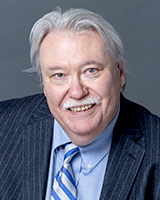 Gibbens took a job at the
North Dakota Office of Rural Health (which eventually
became the Center for Rural Health) at UND, planning to
get professional experience until he found the passion he
was searching for.
Gibbens took a job at the
North Dakota Office of Rural Health (which eventually
became the Center for Rural Health) at UND, planning to
get professional experience until he found the passion he
was searching for.
Thirty-nine years later, Gibbens is ready to retire from the same office. Although he didn't know it in 1985, it turns out his passion was rural health in North Dakota.
From Recruiter to Acting Director
Gibbens, who grew up on a durum wheat farm outside of Cando, North Dakota (Maza Township), was hired to work in health manpower, now known as health workforce. Before he knew it, he'd been conscripted as a physician recruiter.
"I like to joke I was the world's worst physician recruiter," remembers Gibbens. "I never recruited a physician and I was never likely to do so. Fortunately, in the recruitment process, we were doing placement reports associated with the community, describing the community environment and context. They discovered I was a good writer, so I started working on Community Health Needs Assessments and other reports.
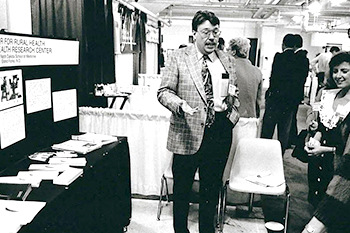
Research Center in 1992.
About two years later, says Gibbens, his team secured its first Rural Health Research Center grant.
"With my background in policy, I became the health policy analyst. In 1991, Dr. Jack Geller, our CRH director, made me an associate director and I became a faculty member. I also assumed the role as the State Office of Rural Health (SORH) director."
Gibbens fully admits today that he had no intention of building a career in rural health. He just "got lucky" he says, and "kept finding things that were fun to do and important to me."
"Opportunity was given to me and I took advantage of it," Gibbens muses. "That is advice I give younger staff to take advantage of every opportunity, learn from it, and over time it will add to your skill set and your value to an employer. Keep learning, always learn, every day. New knowledge never goes to waste."
As he prepares for retirement at the end of the year, Gibbens has spent time thinking about the past four decades and what that has meant for rural health, in and out of North Dakota, and at CRH. During that time he has served as: physician recruiter, health policy analyst, SORH director, North Dakota Medicare Rural Hospital Flexibility (Flex) Program director, editor of the CRH newsletter Focus on Health, CRH associate director, CRH deputy director, and for the past four plus years as the CRH acting director. This is the fourth time in his almost 40 years Gibbens has been either the acting or interim director of the Center.
"I think I am now a semi-professional acting director," said Gibbens, who has served in leadership roles not only with the National Rural Health Association, the National Organization of State Offices of Rural Health, and the North Dakota Rural Health Association, but on numerous state and UND committees. "It seems to be one of my skill sets, and I have always enjoyed it."
You help your state when you serve on national and statewide boards and committees.
He has served in leadership roles with the National Rural Health Association, the National Organization of State Offices of Rural Health, and the North Dakota Rural Health Association. He has served on numerous statewide and UND School of Medicine & Health Sciences (SMHS) committees and functions. He said, "You help your state when you serve on national and statewide boards and committees. It is another way to grow professionally and to make a difference."
The Origins of Rural Health
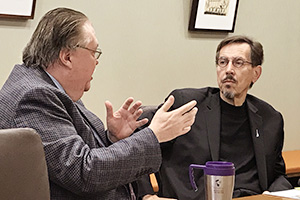
some new projects at CRH.
CRH has been known under several names: the North Dakota Office of Rural Health, the Center for Rural Health Service, Policy, and Research, and finally the Center for Rural Health. The division, within SMHS, was officially created in 1980. The first director and graduate of SMHS, Dr. Kevin Fickenscher, traveled across the state to find out what rural communities needed and wanted. The answer? More physicians and assessments to know what the community needed from their local hospital. Equipped with staff to do the physician recruitment and community health assessments, a new era in rural health was born.
"The Center for Rural Health really began by helping communities address healthcare workforce and understanding community health needs," Gibbens says. "Forty-four years later, we are still doing work focused on those two areas, but we have expanded to meet the needs of the state. We try to help communities address their health workforce needs, help them understand what the needs in the community are, and we also try to help with strategic planning for health facilities, facilitating community dialogues, and identifying financial resources to better serve community needs such as grants, offering grant writing workshops, and providing training and education in all sorts of areas."
Gibbens points out that while CRH still has a strong focus on rural North Dakota it has diversified over the years.
"I am proud that we now have staff and programs addressing rural behavioral and mental health, aging, Indigenous health, human service needs, brain injury, and other significant rural needs," he continues. "I think what we have done is evolve to a broader understanding of health. It is not just healthcare and the system of care, it is not just health organizations, and while that is critical, I believe we have expanded our thinking to be more inclusive – population health, health equity. This is the focus today as the country struggles to find more equitable solutions that benefit all people. And we have a national footprint with six national programs addressing Native American aging, information dissemination, and research dissemination. A lot to be proud of."
Gibbens gave credit for the original idea of a rural health office to Dr. Robert Eelkema, former chair of the Department of Community Medicine at the SMHS. In the 1970s, Eelkema wrote the original grants for the Area Health Education Center, Indians Into Medicine (INMED), the physician assistant program (then known as MEDEX), all while helping guide the School in its transition to becoming a four-year medical school and several others. Many of which are still active.
"Dr. Eelkema had a vision recognizing that North Dakota was a rural state," Gibbens shares. "Bob saw the need that a medical school in a rural state needed some form of organizational rural health presence – hence our birth in 1980. Dr. Fickenscher also added his vision, which in many ways was an orientation to listening to communities and employing a form of public sector entrepreneurship, which I am proud we still follow."
Following Fickenscher, says Gibbens, each subsequent CRH director – Drs. Jack Geller, Mary Wakefield, and Gary Hart – added their own gifts to CRH.
According to Gibbens, by focusing on rural health and having a dedicated office for it, CRH played a "significant role in shaping what we consider the organizational structure of rural health."
Before that, around 1987, the work we were doing on rural health research guided the development of the Rural Health Research program.
"Our primary federal funder, the Federal Office of Rural Health Policy (FORHP), used North Dakota as a model when the federal State Office of Rural Health program was created in 1991," he says. "Before that, around 1987, the work we were doing on rural health research guided the development of the Rural Health Research program. We were doing it before most people were doing it. There were only four other states that had state rural health offices in 1980."
Eventually, the Health Resources and Services Administration and FORHP developed the SORH program, ensuring every state had an office focused on rural health. CRH is the official SORH for North Dakota. The designation helps CRH partner with state medical, hospital, and nursing associations, work with rural economic development groups, and work with the USDA, the North Dakota Department of Commerce, and North Dakota Health and Human Services.
"Being the SORH is a great connector for CRH and SMHS," explains Gibbens. "It allows us to work with so many important stakeholders and partners. And it has given us the opportunity to apply for other federal grants that are tied to a SORH. It is a primary door we use to engage with rural North Dakotans. We certainly have other important programs such as Flex which is very hospital and clinic based, but SORH also connects us directly with public health, economic development, and others."
Structure of Rural Care
One of the opportunities that arose from being the SORH was when CRH received funding from the Centers for Disease Control and Prevention (CDC) to improve health equity. The CDC Health Equity funding first flowed to the North Dakota Health and Human Services, in 2022, and they have been a strong partner. The CDC program guidance required a discussion with the SORH.
"We used our CDC funding to address a range of rural and tribal health issues, including as physical plant planning and assessment for Critical Access Hospitals (CAHs) to be better prepared for future pandemics, addressing community health workforce, understanding the impact of COVID on tribal nations, and finding additional resources to help tribes address behavioral health education and a dedicated effort on restructuring the rural health care and payment systems. All of these were ripe for re-thinking."
The system restructuring area has been to examine a new payment structure for CAHs. This systemic change involves more than rural hospitals and medical providers. Over the past 50 years, the federal government has tried to find a payment/reimbursement structure that works for all hospitals. Unfortunately, urban and rural hospitals operate differently. What works for one, does not necessarily work for the other.
"Rural providers have always faced headwinds with health workforce, and inadequate payment or payment not well aligned for what they do," Gibbens says. "These are twin issues that have challenged providers and policymakers. The goal has always been to increase access while simultaneously trying to control and lower costs. Add into this formula a need to improve quality and health safety.
To that end, Gibbens adds that a new model, "value-based" care, modifies how healthcare is provided and then how it is paid.
CRH has played a significant role in exploring this type of care structure for rural that is called value-based care...
"CRH has played a significant role in exploring this type of care structure for rural that is called value-based care, where providers are payed on showing positive health outcomes, instead of a straight fee for service," said Gibbens of the model that is strongly supported by the Centers for Medicare and Medicaid Services. "We've seen that develop quickly in North Dakota. We used the grant to develop a relationship with an organization with expertise in both rural health and value-based care, called Rural Health Value at the University of Iowa, to conduct education, training, and one-on-one assistance to CAHs in our state."
And so far, so good.
"We had Rural Health Value conduct a number of educational sessions with CAHs and providers to understand the nuts and bolts of value-based care and set up direct technical assistance with five CAHs," Gibbens notes. "Together they ran financial scenarios looking at what happens in 5-10 years if things stay the same, what happens if they are part of an accountable care organization (ACO), and what happens if they are part of another model. The scenario analysis found when CAHs are part of an ACO, there was a positive impact. Today, ACOs are the most common form of value-based care."
As Gibbens put it, a group of 23 CAHs in North Dakota formed their own hospital network, the Rough Rider High Value Network. The group entered into an agreement with an ACO. As a result, North Dakota has 65% of its CAHs in a value-based care structure.
"Everyone is trying to figure out what will work best for rural hospitals to keep them viable," Gibbens says. "North Dakota is a leader in rural health as we test these models. I am very proud that our rural health providers are not afraid to step into the future of healthcare and improved health status.
Additionally, with Rural Health Value we have provided education to public health professionals to help them to understand where and how they fit in a new system of health."
Economics Drive Viability
Viability is essential to maintaining access to healthcare in rural communities, both health facility viability and community viability. Healthcare is often the economic driver in a rural community. Often a local hospital is one of the top two employers. And if that healthcare system also has a clinic and a nursing home, then the system itself becomes the largest employer.
This structure, Gibbens says, results in significant economic impact on the community.
"It makes a difference to the schools, the local tax base, the number of people who can shop locally, and attend church." he says. "A strong rural health system helps to maintain community viability, and a strong community contributes to the viability of the health system." It all intertwines.
Living in a rural community means taking care of your friends, neighbors, and families.
Gibbens continued, "Living in a rural community means taking care of your friends, neighbors, and families. The level of intimacy in rural communities is greater than in urban communities. Everyone is your neighbor: you see them at the grocery store, at church, when you go to a football game. There is a tendency to have more familiarity with and a relationship between people and their healthcare providers, people who work in the clinic, in public health, to the ambulance and the hospital. That is an important role, taking care of one's community."
The economic and population demographics of rural North Dakota are not the same as found in the larger cities. Where rural areas tend to be more dependent on one or two primary economic sectors (such as agriculture and/or energy), urban communities have a more diverse economy. And while urban populations tend to experience steady growth, much of rural North Dakota has experienced population declines over the past 40 or 50 years. Even so, some rural areas have seen acute population spikes due to the expansion of the energy sector. Rural areas tend to be older and less diverse culturally.
"With my background in public administration," said Gibbens, "generally a strong core in political science and organizational theory, also includes sociology. "The people who taught me rural health tended to be sociologists, and even rural sociologists, and that has always guided my thinking. Sociology is why CRH has such a focus on community. But that also means we pay attention to how broader environmental factors – such as economics and population – influence not only community development but also rural health development. You simply cannot understand rural health without understanding community dynamics including social norms and relationships, community history, and just the unique nature of each community."
Or, as Gibbens quips, "the old joke is that if you've been to one rural community, you've been to one rural community. The same holds true for tribal communities. If you stereotype rural or tribal, you miss the uniqueness of each."
Looking for Challenges
Challenges exist for all rural communities, but so do opportunities for change.
"What we have done in our 44 years is constantly try to think of what more we can do," concludes Gibbens. "We don't provide services like medical care, but we try to help the people who do provide health services do their job better, to have access to more resources, to learn about new models and approaches, and to find ways to include the community in their planning. Rural health is always about the community."
Because CRH operates on soft funding, only 10% of its budget comes from state appropriations, explained Gibbens. The other 90% the CRH pursues through state and federal grant opportunities.
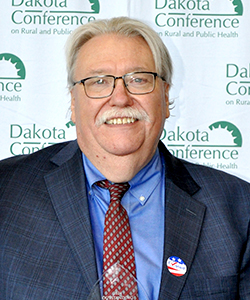
Outstanding Rural Health Career
award at the Dakota Conference on
Rural and Public Health in 2024.
He elaborates on the nature of CRH staff that he says has always been at the heart of the CRH. "We have a culture of entrepreneurship, a culture of really wanting to try to address problems," Gibbens says. "Our staff loves to help people and to make a difference. It was like that in the 1980s and today. Honestly, our staff like problems. They seem to thrive on working toward solutions that improve the lives of rural people."
Many of the grant funded projects have received state, regional, and national attention for the work they are doing in rural health. CRH has set up networks for CAHs and Rural Health Clinics, providing guidance, training, and leadership over ever changing regulations and policies. The North Dakota Brain Injury Network has become nationally known for their education and resources for survivors of brain injuries and those caring for them. Likewise, the North Dakota Qualified Service Provider Hub offers assistance and resources for individual and agency in-home care providers. Two national centers – the National Resource Center on Native American Aging and the Resource Center on Native Aging and Disability – focus on Native American aging and disability. The Rural Health Information Hub is a clearinghouse on rural health issues, and the Rural Health Research Gateway provides access to research publications focused on rural health issues.
It amazes me that an office that started with one person, a director, now has about 70 staff and faculty, 30 or more separate funding sources, and nationally facing programs.
"It amazes me that an office that started with one person, a director, now has about 70 staff and faculty, 30 or more separate funding sources, and nationally facing programs," Gibbens admits. "We are frequently cited as a national leader, and, yes, we have influenced much of the work found elsewhere in rural health. However, always understand rural health is a two-way street and CRH has greatly benefited from other states."
The Future of Rural Health
As he imagines what the next 40 years will bring to rural health, Gibbens explains that CRH exists to help improve and maintain the health status of people who live in these communities. One important development is learning and working with concepts like population health, health equity, social determinants of health, and drivers of health.
"All of those factors flow into value-based care, which is a process that can deal with improved population health," he says. "Health equity is aspirational. It will take many years of hard work to ensure all people, regardless of who they are or where they live, have the same right to good health status."
Even so, Gibbens continued, he has "come to realize we have to think about the overall health status of the population: things in the environment, income level, where people live, job status. All of those factors impact health status."
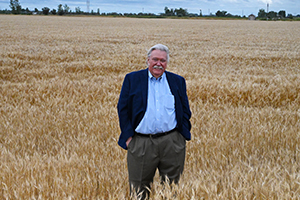 Gibbens never
intended to work in rural health or spend his career as a
champion for improving rural communities through
healthcare. In fact, he considered leaving UND and North
Dakota, a time or two. But once he found his passion, he
never looked back.
Gibbens never
intended to work in rural health or spend his career as a
champion for improving rural communities through
healthcare. In fact, he considered leaving UND and North
Dakota, a time or two. But once he found his passion, he
never looked back.
"I've had a career where I have been able to help the people I grew up with," he smiles. "I get a genuine thrill when I am able to get into the car and drive out to a rural community and do something with the people there. I enjoy working with people who are so committed to their towns. I've had opportunities to do other things, but it always came back to: I am a farm boy from rural North Dakota, so I decided to stay here."


 is the communications manager at the Center for Rural
Health at the University of North Dakota School of
Medicine & Health Sciences in Grand Forks.
is the communications manager at the Center for Rural
Health at the University of North Dakota School of
Medicine & Health Sciences in Grand Forks.



